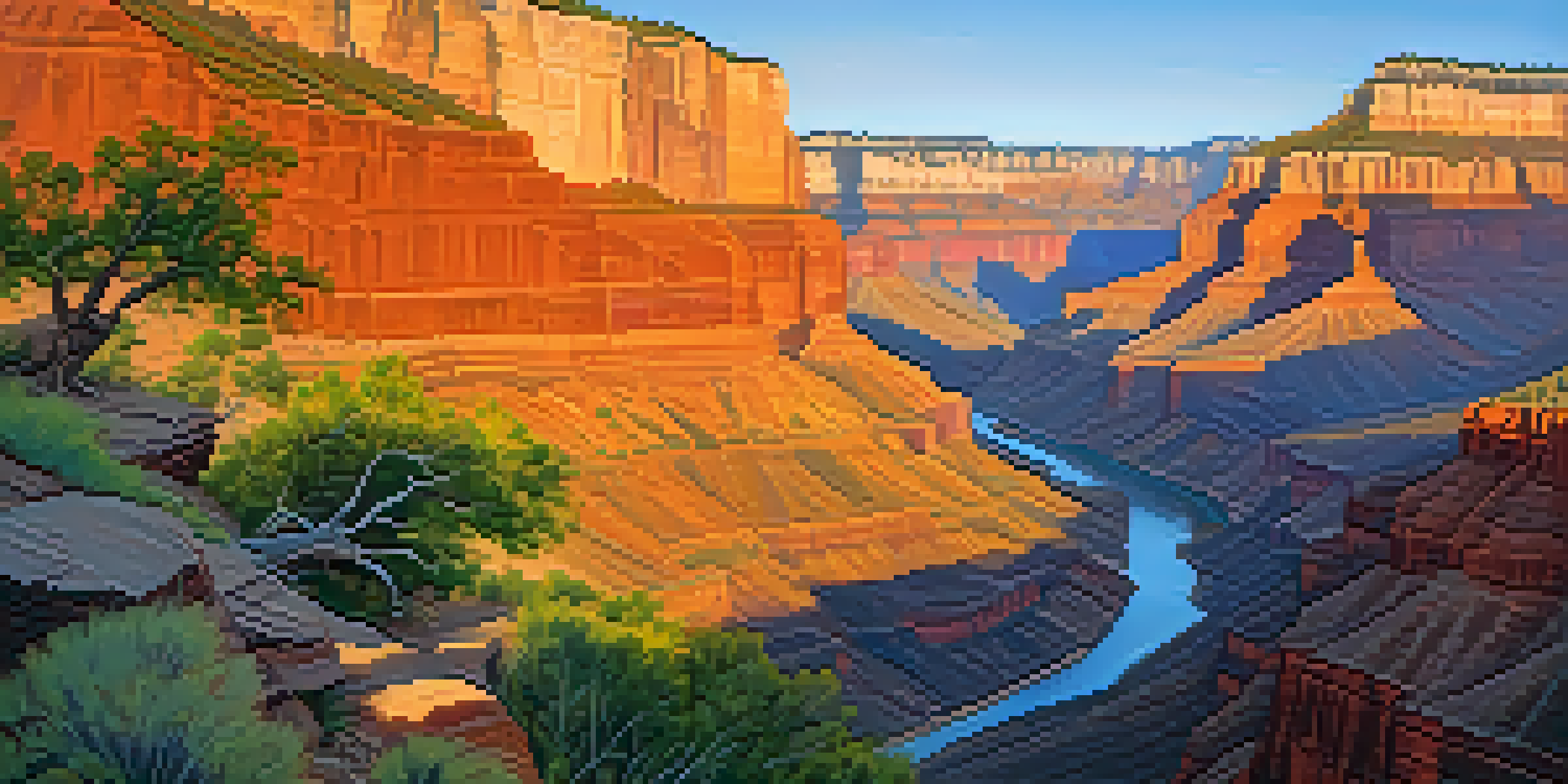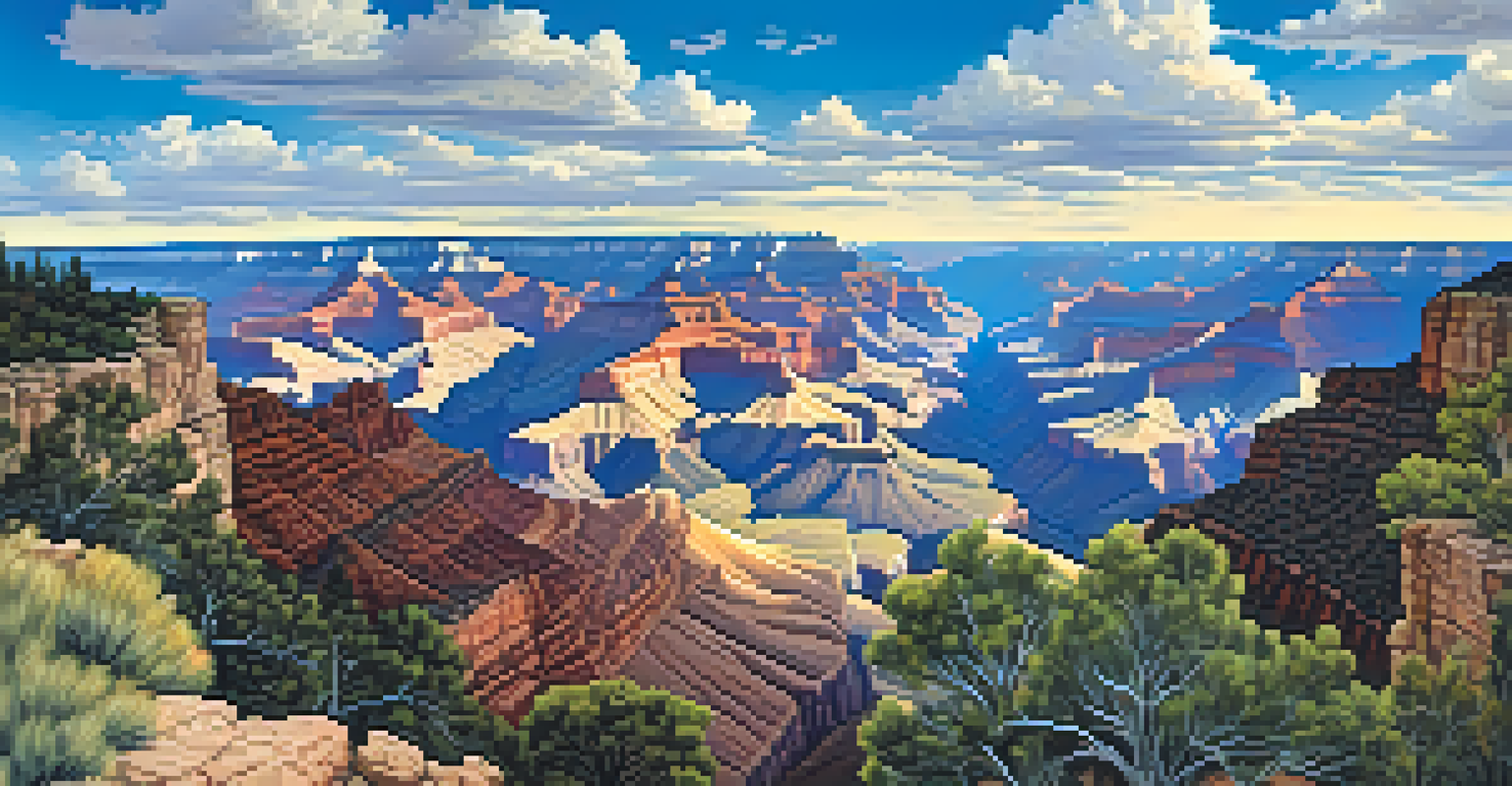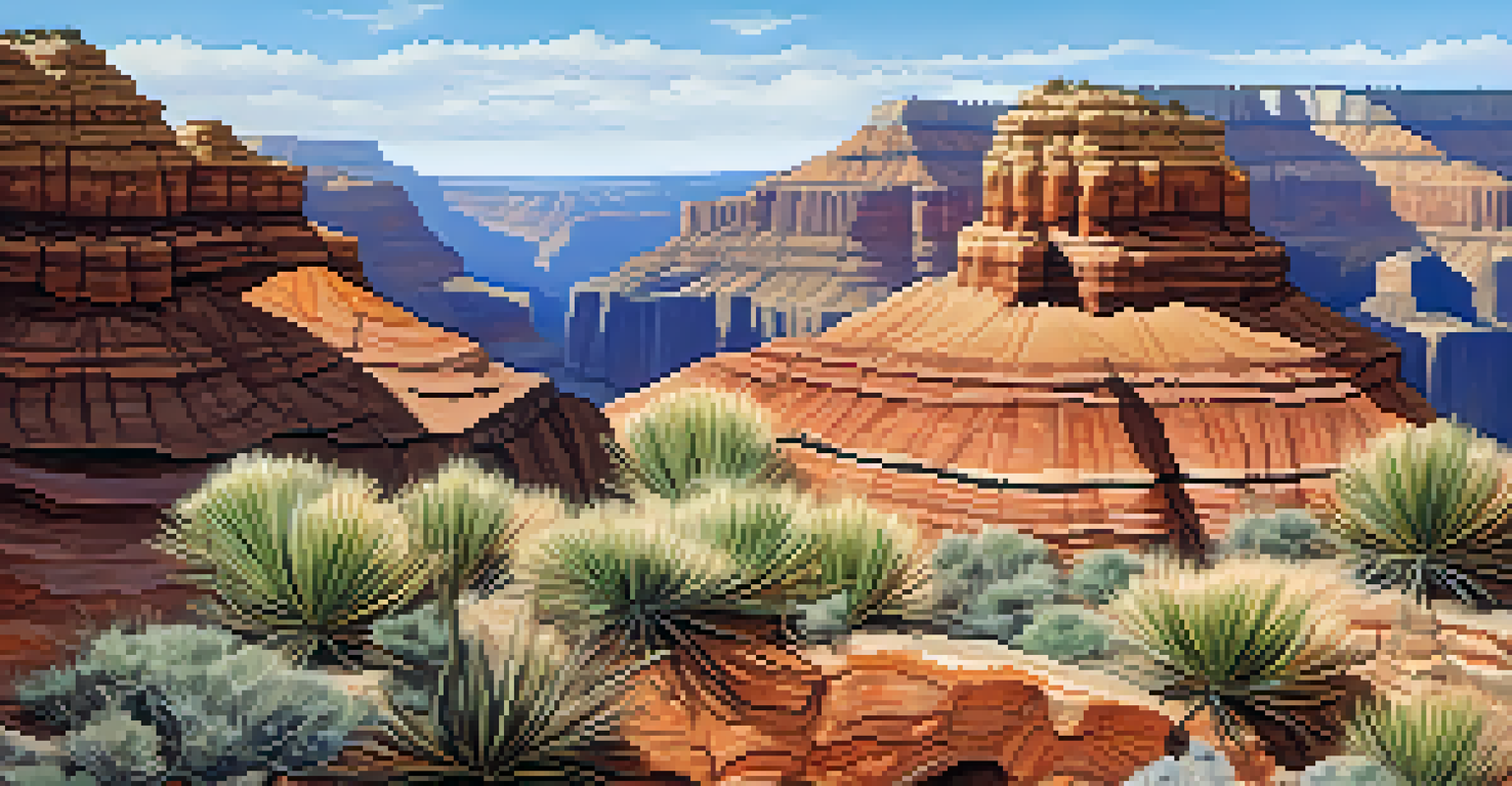The Grand Canyon: Arizona's Iconic Landmark and Its Impact

An Overview of the Grand Canyon's Stunning Geography
The Grand Canyon, a breathtaking showcase of nature's artistry, stretches over 277 miles in Arizona. This immense chasm, carved by the Colorado River, reaches depths of around a mile, revealing layers of geological history. From its vibrant red rocks to the serene blue waters of the river below, the canyon offers a visual feast that attracts millions of visitors each year.
The Grand Canyon is a natural wonder that inspires awe and reflection.
Its unique topography features various ecosystems, from desert scrub to lush forests, supporting diverse wildlife. Whether you're hiking along the rim or exploring the trails below, each vantage point presents a new perspective on this natural wonder. The interplay of light and shadow at sunrise and sunset transforms the canyon into a canvas of shifting colors, making it a photographer's paradise.
The sheer scale and beauty of the Grand Canyon make it a natural wonder that inspires awe and reflection. It serves as a reminder of the Earth’s dynamic processes and the forces that shape our planet. For many, standing at the rim evokes a sense of humility and connection to the world around us.
The Rich History of the Grand Canyon
The Grand Canyon has been a significant site for thousands of years, with ancient Native American tribes calling it home. The Havasupai, Hopi, and Navajo peoples, among others, have deep cultural ties to the land, viewing it as sacred. Their histories, stories, and traditions are woven into the fabric of the canyon’s landscape, making it a repository of cultural heritage.

European exploration began in the 16th century, but it wasn't until the late 19th century that the Grand Canyon gained broader attention. John Wesley Powell’s famous expedition in 1869 opened the eyes of many to its grandeur and potential for scientific study. This sparked interest in preserving the canyon and led to its designation as a national park in 1919.
Grand Canyon's Natural Beauty
The Grand Canyon's stunning geography showcases diverse ecosystems and geological history, making it a captivating destination for millions of visitors each year.
Today, the Grand Canyon stands as a symbol of natural preservation, reminding us of the importance of safeguarding our natural wonders. Its history reflects the ongoing relationship between humans and the environment, highlighting the need for respect and conservation of such irreplaceable sites.
Cultural Significance of the Grand Canyon
The Grand Canyon is not just a natural wonder; it also holds profound cultural significance for many Indigenous tribes. The canyon is often viewed as a living landscape, imbued with spirituality and stories that have been passed down through generations. Rituals, ceremonies, and traditional practices rooted in the canyon's geography reflect the deep respect these communities have for their ancestral land.
In every walk with nature, one receives far more than he seeks.
Furthermore, the Grand Canyon has inspired countless artists, writers, and filmmakers. Its dramatic vistas have found their way into various forms of art, serving as a muse for creativity and expression. From Edward Abbey’s environmental writings to the stunning visuals in movies, the canyon has become a cultural icon that transcends its physical boundaries.
This cultural resonance extends beyond the arts, influencing contemporary discussions about land use and environmental stewardship. The Grand Canyon's status as a symbol of natural beauty fuels efforts to protect not just the canyon itself but also the broader landscape in which it resides, highlighting the interconnectedness of culture and nature.
Tourism and Its Economic Impact
Tourism plays a vital role in the economy surrounding the Grand Canyon, drawing nearly six million visitors annually. This influx of tourists supports local businesses, from hotels and restaurants to tour companies and gift shops. It’s a bustling hub of activity, where visitors seek adventure, education, and relaxation amidst stunning scenery.
However, with the benefits of tourism come challenges, including environmental concerns and resource management. The increasing number of visitors puts pressure on the natural environment, prompting discussions on sustainable tourism practices. Balancing the economic benefits while preserving the canyon's beauty is an ongoing challenge for stakeholders.
Cultural Heritage and Significance
The Grand Canyon holds deep cultural ties for Indigenous tribes, reflecting a rich history of spirituality and connection to the land.
Efforts are being made to promote responsible tourism, ensuring that future generations can enjoy the canyon’s splendor. Through educational programs and initiatives aimed at minimizing impact, there’s a collective push to protect this iconic landmark while supporting the local economy.
Environmental Challenges Facing the Grand Canyon
The Grand Canyon, despite its majesty, faces several environmental challenges that threaten its ecosystem. Issues such as climate change, invasive species, and water management are critical concerns for conservationists. Fluctuations in temperature and precipitation patterns affect the delicate balance of life within the canyon, prompting ongoing research and monitoring.
One of the most pressing issues is the impact of water use from the Colorado River. As a vital resource for multiple states, the river's water levels are subject to competing demands, affecting both the canyon's environment and the communities that depend on it. Conservation efforts are essential to ensure that water resources are managed sustainably for both human and ecological needs.
Additionally, the introduction of non-native species can disrupt the native flora and fauna, leading to a loss of biodiversity. Addressing these environmental challenges requires collaboration among local agencies, tribal nations, and conservation organizations to develop effective strategies for protecting the Grand Canyon's unique ecosystems.
The Role of Education in Conservation
Education plays a crucial role in promoting conservation efforts for the Grand Canyon. Through visitor centers, ranger-led programs, and educational materials, the National Park Service aims to raise awareness about the canyon’s ecology and history. Understanding the importance of preserving such a landmark fosters a sense of stewardship among visitors.
Schools and organizations also contribute by organizing field trips and educational camps, allowing students to experience the canyon firsthand. These immersive experiences help cultivate a deeper appreciation for the natural world and the need for conservation efforts. Learning about the canyon's unique ecosystems inspires the next generation to advocate for environmental protection.
Tourism's Economic Contributions
Tourism significantly impacts the local economy, bringing in nearly six million visitors annually while presenting challenges for sustainable management.
Moreover, partnerships with local communities and Indigenous tribes enhance educational initiatives, integrating traditional knowledge with scientific understanding. This collaborative approach enriches the narrative of the Grand Canyon, emphasizing the importance of diverse perspectives in conservation efforts.
The Future of the Grand Canyon
Looking ahead, the future of the Grand Canyon hinges on sustainable practices and community involvement. As tourism continues to grow, it becomes increasingly important to implement measures that protect the canyon’s natural beauty. Engaging local communities, Indigenous tribes, and visitors in conservation efforts can foster a collective responsibility for the land.
Innovative approaches, such as renewable energy projects and responsible water management, can help mitigate some of the environmental challenges facing the canyon. Investing in research and technology will be essential to monitor the impacts of climate change and develop adaptive strategies. By prioritizing sustainability, we can ensure that the Grand Canyon remains a treasured landmark for generations to come.

Ultimately, the Grand Canyon represents a unique intersection of nature, culture, and history. As we navigate the complexities of conservation, it serves as a reminder of our responsibility to protect and cherish the natural world. With continued dedication and collaboration, the Grand Canyon can thrive, inspiring awe and wonder for all who visit.